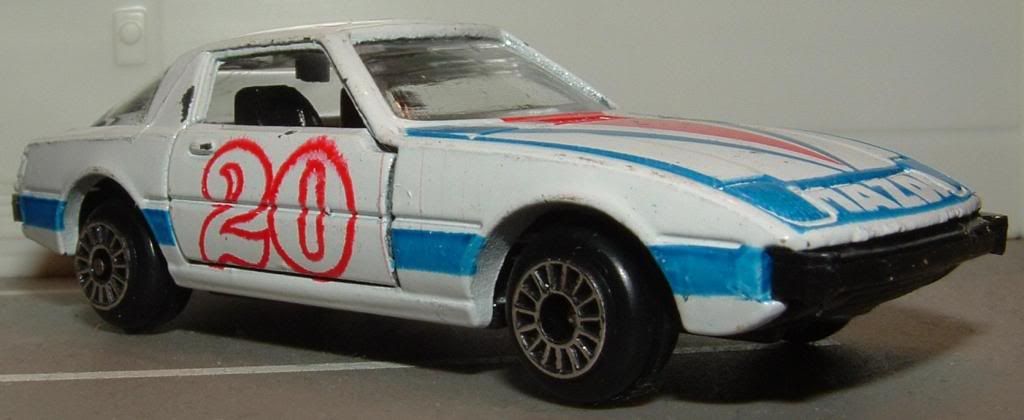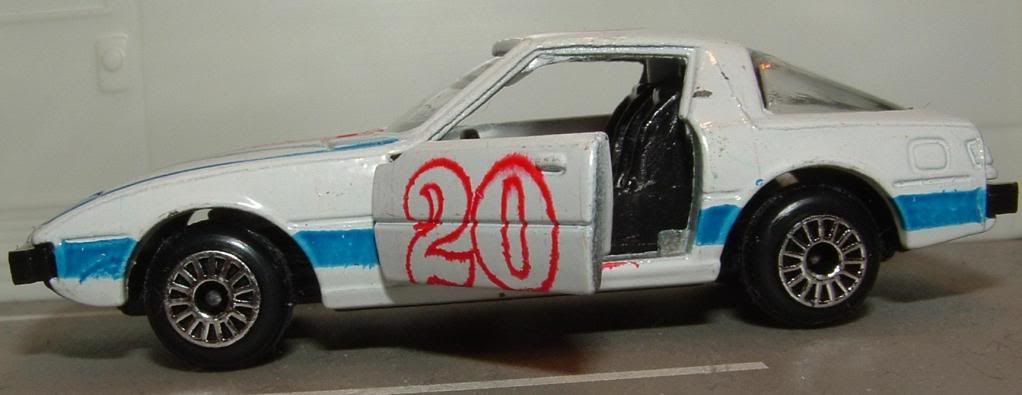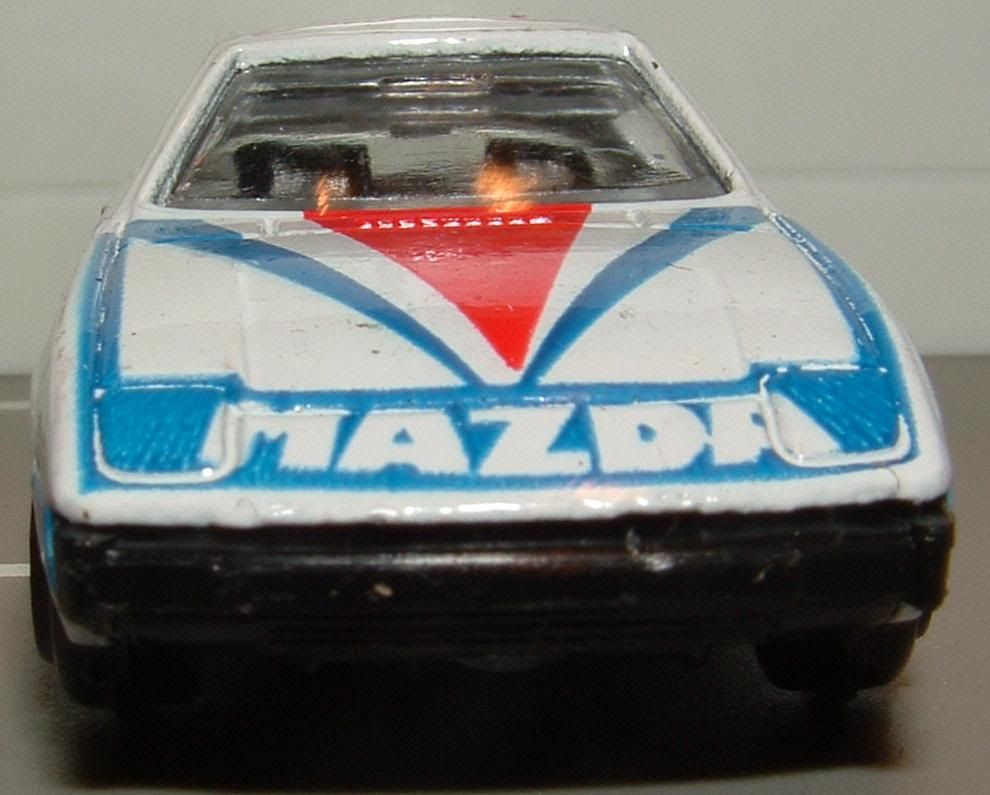Today's car of the day is Zylmex's 1979 Mazda RX-7.
The Mazda RX-7 is a sports car by the Japanese automaker Mazda. It was produced from 1978 to 2002. The original RX-7 featured a 1146 cc twin-rotor Wankel rotary engine and a sporty front-midship, rear-wheel drive layout. The RX-7 was a direct replacement for the RX-3 (both were sold in Japan as the Savanna) and subsequently replaced all other Mazda rotary cars with the exception of the Cosmo.
The original RX-7 was a sports coupé. The compact and lightweight Wankel engine (rotary engine) is situated slightly behind the front axle, a configuration marketed by Mazda as "front mid-engine". It was offered as a two-seat coupé, with optional "occasional" rear seats in Japan, Australia, the United States, and other parts of the world. These rear seats were initially marketed as a dealer-installed option for the North American markets.
The RX-7 made Car and Driver magazine's Ten Best list five times. In total, 811,634 RX-7s were produced.
For more information and pictures of the real car please visit: Mazda RX-7
A recent RAOK from Stangfreak brought this one to my collection. Thanks Steve! This has been on my want list for awhile- ever since I saw one in a beater box (3 for $1) and I passed on it. I went back for it and it was gone, and I've kicked myself ever since. Now, I can stop kicking!
Series 1 (1979–1980) is commonly referred to as the "SA22C" from the first alphanumerics of the vehicle identification number. This series of RX-7 had exposed steel bumpers and a high-mounted indentation-located license plate, called by Werner Buhrer of Road & Track magazine a "Baroque depression."
In 1980 Mazda released 3000 special models known as the LS (Leather Sport). This package added an LS badge, full leather upholstery, sunroof, and gold-colored alloys. This model was only available in three different colors Aura White (1250 made), Brilliant Black (1250 made) and Solar Gold (500 made).
The Series 2 (1981–1983) had integrated plastic-covered bumpers, wide black rubber body side moldings, wraparound taillights and updated engine control components. The GSL package provided optional 4-wheel disc brakes, front ventilated (Australian model) and clutch-type rear limited slip differential (LSD). Known as the "FB" in North America after the US Department of Transportation mandated 17 digit Vehicle Identification Number changeover. Elsewhere in the world, the 1981-1985 RX-7 retained the 'SA22C' VIN prefix. As a result, enthusiasts outside North America never picked up the "FB" nickname. The license-plate surround looks much like Buhrer's "Styling Impressions."
The Series 3 (1984–1985) featured an updated lower front fascia. North American models received a different instrument cluster (the NA S3 RX-7 is the only rotary-engined car to not have a centrally mounted tachometer). GSL package was continued into this series, but Mazda introduced the GSL-SE sub-model. The GSL-SE had a fuel injected 1.3 L 13B RE-EGI engine producing 135 hp (101 kW) and 135 lb·ft (183 N·m). GSL-SEs had much the same options as the GSL (clutch-type rear LSD and rear disc brakes), but the brake rotors were larger, allowing Mazda to use the more common lug nuts (versus bolts), and a new bolt pattern of 4x114.3 (4x4.5"). Also, they had upgraded suspension with stiffer springs and shocks. The external air-oil oil cooler was reintroduced, after being dropped in the 1983 model-year for the controversial "beehive" water-oil heat exchanger.
The 1984 RX-7 G has an estimated 29 highway miles per gallon (8.11 litres per 100 km) /19 estimated city miles per gallon (12.37 l/100 km). According to Mazda, its rotary engine, licensed by NSU-Wankel allowed the RX-7 G to accelerate from 0 to 50 (80 km/h) in 6.3 seconds. Kelley Blue Book, in its January-February 1984 issue, noted that a 1981 RX-7 G retained 93.4% of its original sticker price.
The handling and acceleration of the car were noted to be of a high caliber for its day. This generation RX-7 had "live axle" 4-link rear suspension with Watt's linkage, a 50/50 weight ratio, and weighed under 2500 lb (1100 kg). It was the lightest generation of RX-7 ever produced. 12A-powered models accelerated from 0–60 mph in 9.2 s, and turned 0.779g (7.64 m/s²) laterally on a skidpad. The 12A engine produced 100 hp (75 kW) at 6000 rpm, allowing the car to reach speeds of over 120 miles per hour (190 km/h). Because of the smoothness inherent in the Wankel rotary engine, little vibration or harshness was experienced at high rpm, so a buzzer was fitted to the tachometer to warn the driver when the 7000 rpm redline was approaching.
The 12A engine has a long thin shaped combustion chamber, having a large surface area in relation to its volume. Therefore, combustion is cool, giving few oxides of nitrogen. However, the combustion is also incomplete, so there are large amounts of partly burned hydrocarbons and carbon monoxide. The exhaust is hot enough for combustion of these to continue into the exhaust. An engine driven pump supplies air into the exhaust to complete the burn of these chemicals. This is done in the "thermal reactor" chamber where the exhaust manifold would normally be on a conventional engine. Under certain conditions the pump injects air into the thermal reactor and at other times air is pumped through injectors into the exhaust ports. This fresh air is needed for more efficient and cleaner burning of the air/fuel mixture.
Options and models varied from country to country. The gauge layout and interior styling in the Series 3 was only changed for North American versions. Additionally, North America was the only market to have offered the first generation RX-7 with the fuel injected 13B, model GSL-SE. A turbocharged (but non-intercooled) 12A engine was available for the top-end model of Series 3 in Japan.
Sales were strong, with a total of 474,565 first generation cars produced; 377,878 were sold in the United States alone. In 2004, Sports Car International named this car #7 on its list of Top Sports Cars of the 1970s. In 1983, the RX-7 would appear on Car and Driver magazine's Ten Best list.
Racing versions of the first-generation RX-7 were entered at the prestigious 24 hours of Le Mans endurance race. The first outing for the car, equipped with a 13B engine, failed by less than one second to qualify in 1979. The next year, a 12A-engine car not only qualified, it placed 21st overall. That same car did not finish in 1981, along with two more 13B cars. Those two cars were back for 1982, with one 14th place finish and another DNF. The RX-7 Le Mans effort was replaced by the 717C prototype for 1983. In 1991, Mazda became the first Japanese manufacturer to win the 24 hours of Le Mans. The car was a 4-rotor prototype class car, the 787B. The FIA outlawed rotary engines shortly after this win. To this day the rotary powered Mazda is the only Japanese manufacturer to have ever won the prestigious 24 hour Le Mans race outright.
Mazda began racing RX-7s in the IMSA GTU series in 1979. That first year, RX-7s placed first and second at the 24 Hours of Daytona, and claimed the GTU series championship. The car continued winning, claiming the GTU championship seven years in a row. The RX-7 took the GTO championship ten years in a row from 1982. The RX-7 has won more IMSA races than any other car model.In the USA SCCA competition RX-7s were raced with great success by Don Kearney in the NE Division and John Finger in the SE Division. Pettit Racing won the GT2 Road Racing Championship in 1998. The car was a 93 Mazda RX-7 street car with only bolt-on accessories. At season end Pettit had 140 points - 63 points more than the 2nd place team. This same car finished the Daytona Rolex 24-hour race 4 times.
The RX-7 also fared well at the Spa 24 Hours race. Three Savanna/RX-7s were entered in 1981 by Tom Walkinshaw Racing. After hours of battling with several BMW 530i and Ford Capri, the RX-7 driven by Pierre Dieudonné and Tom Walkinshaw won the event. Mazda had turned the tables on BMW, who had beaten Mazda's Familia Rotary to the podium eleven years earlier at the same event. TWR's prepared RX-7s also won the British Touring Car Championship in 1980 and 1981, driven by Win Percy.
Canadian/Australian touring car driver Allan Moffat was instrumental in bringing Mazda into the Australian touring car scene. Over a four year span beginning in 1981, Moffat took the Mazda RX-7 to victory in the 1983 Australian Touring Car Championship, as well as a trio of Bathurst 1000 podiums, in 1981 (3rd with Derek Bell), 1983 (second with Yoshimi Katayama) and 1984 (third with former motorcycle champion Gregg Hansford). Australia's adoption of international Group A regulations, combined with Mazda's reluctance to homologate a Group A RX-7, ended Mazda's active participation in the touring car series at the end of the 1984 season.
The RX-7 even made an appearance in the World Rally Championship. The car finished 11th on its debut at the RAC Rally in Wales in 1981. Group B received much of the focus for the first part of the 1980s, but Mazda did manage to place third at the 1985 Acropolis Rally, and the Familia 4WD claimed the victory at Swedish Rally in both 1987 and 1989.
The FC and FD are considered popular choices for drifting contests, given their short wheelbase and an average of 450 bhp (336 kW). Youichi Imamura won the D1 Grand Prix title in 2003 and Masao Suenaga almost won his in 2005, both in FDs.
In Japan, the RX-7 has always been a popular choice in domestic events, competing in Group 5 based Formula Silhouette to its modern day incarnation, the Super GT series from when the Japan Sport Sedan series would become the GT300 category which it had been competing in. Its patience would pay off as in 2006, RE Amemiya Racing Asparadrink FD3S won the GT300 class championship.








No comments:
Post a Comment